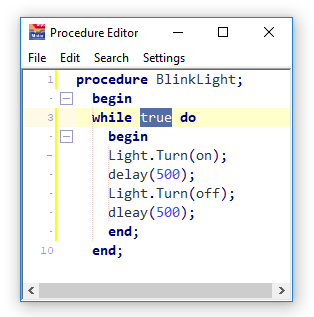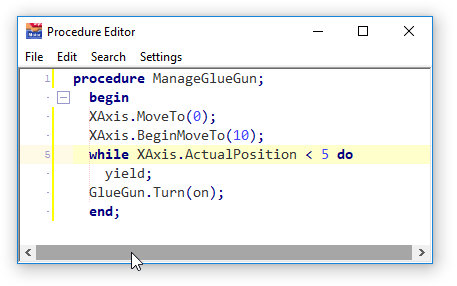
Description
A "While..Do" loop is used to perform a group of instructions while a certain condition remains true. The syntax of a "while..do" loop is:
while <expression> do <statement>;The expression is evaluated and if found to be true the statement is executed. This continues until the expression is found to be false. For example:
While not MovementFile.EndOfFile do begin MovementFile.Readln(XCoord,YCoord); XYAxis.MoveTo(XCoord,YCoord); end;This checks to insure there is information remaining in the MovementFile (a TFile accesses files on the PC). If information is still in the file that information is retrieved and the motion system moves to that location until the information is all used. This will iterate various numbers of times depending on how many coordinate pairs are in the file. Note also that if there is no information in the file this loop never executes at all, i.e. it handles the empty case.
While loops are best for iteration where the number of times desired may be unknown and the number of times might be none at all.
There are some cases where an infinite loop is required. This is is most simply done in with a while..do loop with a conditon being the boolean constant "true"
True is always true;
There are some synchronizing tasks where the objective is to do nothing at all until a certain event occurs and then to proceed with an operation. For example you might want to turn on a glue gun after the x axis has passed 5:
Note the "yield" instruction inside the otherwise "empty" while statement. For some single-tasking systems, doing nothing is an option but in a multitasking system doing nothing is quite selfish. The controller uses a cooperative multitasking architecture. If a task is simply waiting it is important to yield to other system activities. Yield is a multitasking management procedure that directs a task to give up execution because the application developer knows that nothing interesting will happen until the next controller sample. Execution will return to this procedure in the next millisecond if the controller sample rate is set to 1 kHz. It is extremely important that the yield is present. A task must not attempt to control the CPU for longer than it's share of the sample. Forgetting the yield instruction in an indefinite loop can cause the controller to lock. Principles of multitasking will be discussed later at greater length however the point to be made here is that there are usually no empty loops.

